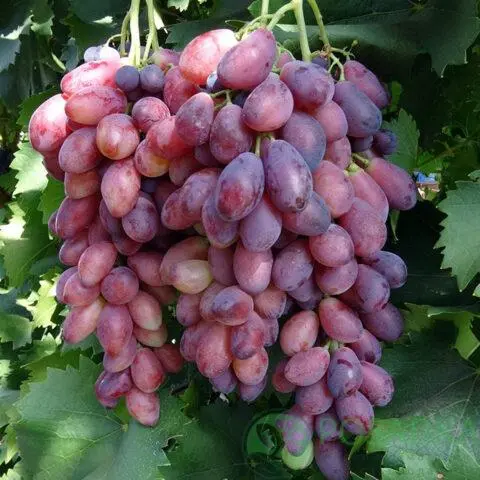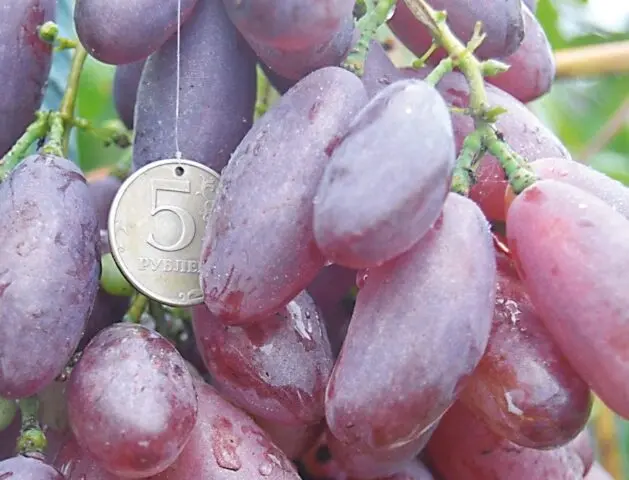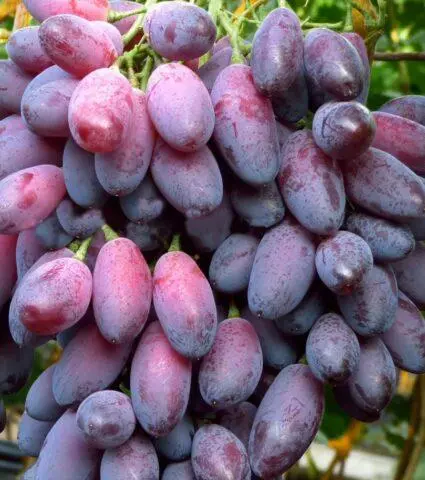Contents
Grape Asya is a Ukrainian variety, quite well known in Our Country. Differs in very large berries of red-violet color. The taste is sweet, pleasant, almost without sourness. The hybrid is quite resistant to winter, so it can be grown even in certain areas of the middle lane.
The story of
Grapes Asya is a hybrid variety bred by the national breeder Zagorulko V.V. (Ukraine, Zaporozhye region). He began to carry out crossbreeding work back in the 1990s. Thanks to this, in recent years it has been possible to develop several varieties and hybrid forms.
For example, Asya grapes are obtained by crossing the Dunav and Demeter varieties. Bush with great vigor, good yield and tasty berries. The culture is not included in the register of breeding achievements. Due to relatively good winter hardiness, it has spread to different regions of the country.
Description of Asya grapes
Asya grape bushes are tall, and their growth strength is good, but if the plant is grafted, it is average. The crowns of young shoots are closed and do not have pubescence. The leaves are yellowish-green in color, the edge is purple, dark red. The shape is typical five-lobed, with a strong dissection.
The profile of Asya grape leaves is wavy. The edges of the blades are lowered, the surface is smooth. At the same time, the adult foliage is painted in a dark green color, against which light veins are clearly visible. Side cutouts on top are deep, mostly open, lyre-shaped, slit-like. The bottom is pointed.
The lower cutouts of Asya grape leaves are much smaller in size, barely outlined. The petiolate notches are vaulted or lancet, sometimes lyre-shaped, the bottom is sharp. The petioles are moderately long, the color is greenish, there are longitudinal stripes of red.

Hybrid Asya is distinguished by large berries of an unusual shape
Along the edges of the grape leaves there are teeth, they are moderately large, triangular. The edges are straight or slightly curved, the tops are pointed. Flowers are female only. Therefore, pollination of Asya necessarily requires the planting of bisexual flowers. Flowers and ovaries usually do not crumble, which ensures a good harvest.
bunches
Clusters of Asya hybrid grapes are regular conical or cylindrical-conical in shape, slightly elongated. In length, they reach 40-50 cm. At the same time, the average weight is from 700 g to 1 kg. In favorable weather conditions and subject to the rules of agricultural technology, very large clusters weighing up to 1,5 kg can be obtained.
The brush is moderately loose, so the berries are not squeezed, they normally endure transportation to the place of sale or processing. Their combs are strong and long, well branched, the color is light green.
Berries
Asya grape berries are large, on average, the weight of one piece is 13-14 g. The shape is obovate, the surface is smooth red-violet. Outwardly, they look very attractive, because the fruits are aligned, uniform. There is a wax coating on the surface, which is easy to wipe off with a finger.
Vine
Asya grape vine is quite strong, ripens evenly and in a timely manner. As it matures, it becomes brown, often with a reddish tinge.
Characteristics of Asya grapes
Asya hybrid adapts well to different climatic conditions. The culture is productive, gives large and tasty berries of a trade dress. In most regions, it needs winter shelter.
Asya grape ripening period
In the conditions of the southern regions of Our Country, the Asya crop ripens in the third decade of August, i.e. around the beginning of September. In other areas, the deadlines are shifted by several days. The full vegetation cycle of Asya grapes from bud swelling to fruit ripening ranges from 120 to 130 days.
Productivity
The culture is characterized by high productivity – 8-10 kg of berries are harvested from one bush. Subject to careful observance of agricultural technology and in good weather, you can get up to 20 kg
Palatability
The taste of Asya grapes is sweet, with a delicate sourness, quite harmonious. The pulp is dense, fleshy, juicy. At the same time, there is no particular aroma. The skin is thin and when biting through its presence is imperceptible.

Berries are juicy and sweet
The total sugar content in grape juice is about 17-19 g per 100 ml. The indicator of titratable acidity is 4-5 g per 1 liter. Due to this, the sour taste is almost not felt. Each berry contains 2-3 seeds. Moreover, the pulp has a large volume, so the bones are also hardly noticeable.
Growing regions
It was noted that for full ripeness, the sum of active temperatures per season should be at least 2600 degrees. Therefore, Asya grapes can be grown not only in the southern regions, but also in the Volga and Chernozem regions, and partly in the middle lane. The northern border of distribution passes along the conditional line “Lipetsk – Tambov – Orel”.
Frost resistance
The winter hardiness index reaches -20 degrees – it is at such a minimum temperature that Asya grapes can normally survive frosts and recover in spring. Therefore, in the regions of the North Caucasus, in the Krasnodar Territory and neighboring regions, it is not necessary to cover it for the winter (although some gardeners recommend doing this). In other regions, mandatory preparation for the winter period is required.
Drought tolerance
The drought resistance of Asya grapes is not very high. The variety may suffer from prolonged heat and dry winds. Therefore, during such periods, it needs additional enhanced watering.
Disease and pest resistance
The immunity of Asya grapes is not bad – subject to the rules of care, he does not suffer from diseases. But with excessive watering, rare top dressing, it can get sick with chlorosis, oidium, anthracnose, mildew. At the beginning of spring, at least two preventive treatments should be carried out using fungicides:
- “RAW”;
- “Score”;
- “Abiga Peak”;
- “Fundazol” and others.
To protect Asya grapes from ticks, pruritus, leafworms and other pests, they are treated with insectoacaricides:
- “Kleschevit”;
- “Matrin Bio”;
- “Fufanon”;
- “Coragen”.
Application
Asya grape berries are mainly consumed fresh. They have a good presentation, so they can be used for sale. It can also be sent for processing, home conservation. Cooked products (jam, jelly, juices) are distinguished not only by their pleasant taste, but also by their rich color.
Advantages and disadvantages
Asya grapes are valued for very large, attractive berries with a pronounced sweet taste. The yield of the crop is really high, so the bushes can be grown both for their own needs and for commercial purposes.

The berries are large, clusters of the correct conical shape
Pros:
- dessert taste;
- attractive presentation;
- high yield;
- large bunches;
- relatively high winter hardiness;
- good immunity to diseases;
- keeping quality.
Cons:
- in the Moscow region and neighboring regions may not have time to ripen;
- planting of pollinators is required;
- berries have no flavor;
- bushes need to install supports;
- drought resistance is low.
Features of landing
It is better to plant seedlings in a sunny, fairly dry area, protected from through winds. It is recommended to plan the procedure for September, 1-1,5 months before the first frost. Since the hybrid bushes are quite tall and spreading, the interval between the pits should be at least 1,5 m, and between the rows – from 2 m.
Planting holes are dug in a month. They must first be fertilized and watered. The soil should be not only fertile, but also light. As a basis, you can take turf land, peat, humus and sand in a ratio of 2: 1: 1: 1.
Care instructions
Asya grape care is simple, but there are several features:
- Watering is regular, quite plentiful – an adult bush requires at least 30 liters.
- Top dressing is applied only from 3-4 years after planting.
- Shoots must be tied up, as they can break under the weight of the crop and gusts of wind.
- For the winter, the near-trunk circle is carefully mulched, and the processed and cut vine is laid on plywood, covering it with a dense film or agrofiber on top.

Regular fertilizing and watering ensures very good yields.
Conclusion
Asya grapes are a rather interesting variety, which is primarily valued for its large fruit and high yield. The berries are juicy, tasty, and they tolerate transportation well. When leaving, it should be taken into account that the vine can break under the weight of the crop. Another important point is that pollinators must be planted next to the bushes.









